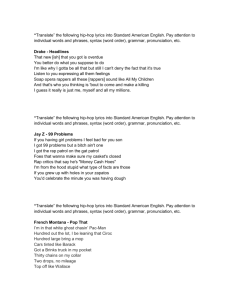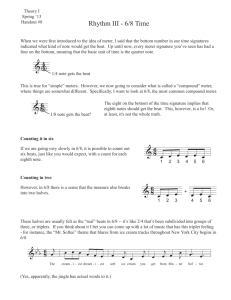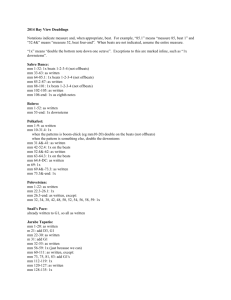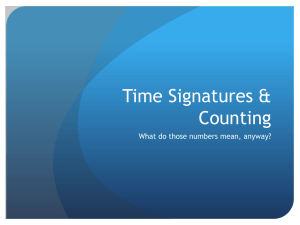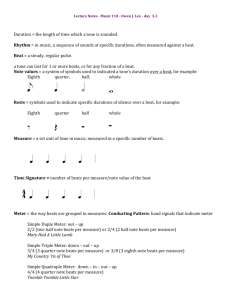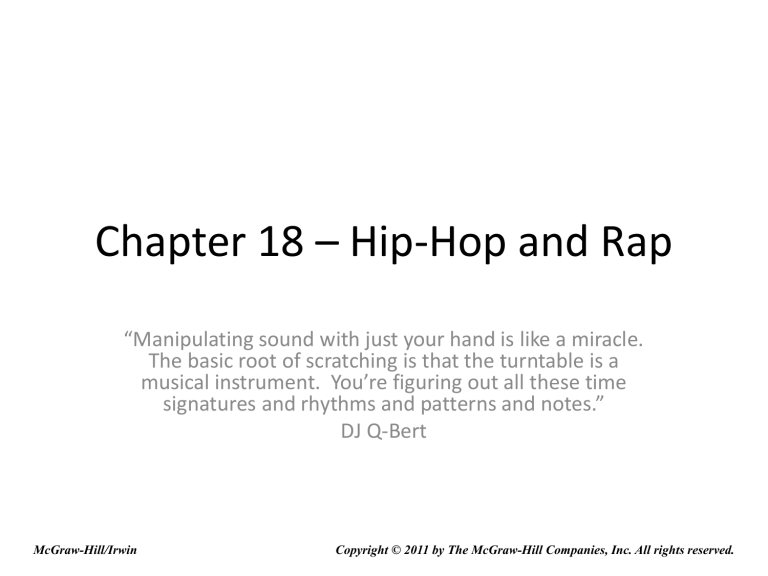
Chapter 18 – Hip-Hop and Rap
“Manipulating sound with just your hand is like a miracle.
The basic root of scratching is that the turntable is a
musical instrument. You’re figuring out all these time
signatures and rhythms and patterns and notes.”
DJ Q-Bert
McGraw-Hill/Irwin
Copyright © 2011 by The McGraw-Hill Companies, Inc. All rights reserved.
Spoken Word
Importance of spoken poetry in Africa and by African
Americans:
Griot singers
Spirituals with two levels of meaning in text, called
“signifying”
Harlem Renaissance writers use of “ghetto” language
Spoken sections in country blues and other music
during the twenties and after
The Last Poets, 1970 in New York used patter-spoken lyrics
in support of civil rights and African polyrhythmic
drumming as accompaniment
Jamaican disc jockeys use of patter-talk called toasting
18-2
Hip-Hop Culture and East Coast Rap
Popularity of competitive break dancing in New York’s South
Bronx, Queens, and Brooklyn
Disc jockeys provided music for dancers on street corners
DJ Kool Herc, from Jamaica, added the use of two turntables
and sound manipulation used in Jamaica for New York
dancers
Jamaican style of “toasting” or patter talking to recordings
added to DJ’s style
Afrika Bambaataa, another early hip-hop disc jockey and
toaster organized neighbors into the Zulu nation and
further developed turntable techniques
“Tagging,” developed into elaborate urban graffiti art form
18-3
Break Dancing Techniques
B-boy/B-girl – A breakdancer
Electric boogie – Controlled movements that begin at one appendage
and gradually shift to other parts of the body in a wavelike motion
Locking – A move in which appendages relax and then jerk back into
position
Moonwalk – A mimelike motion in which the dancer stays in one place
while moving as if walking
Popping – A move in which appendages jerk as if put out of joint
Robot – A style in which individual body parts move while the rest of
the body is stationary
Spins – The dancer places his or her head, back, or hand on the ground
and spins around like a top
Up-rocking – Martial-arts-like motions
18-4
The Language of the Hip-Hop Disc
Jockey
Backspinning – Turning or spinning the record back to the desired place
Beat box- A Vox percussion box with keys that play the sounds of bass and
snare drums as well as high-hat, castanets, and timbales
Beat juggling – Re arranging the beat with fast changes from one record to
another
Breakdown – A DJ’s slowing down a drum pattern by stopping the record
between beats and playing beats from a second record between them
Cutting – Segueing one recording into another using a varispeed control to
maintain a constant beat pattern through the change
Double backing – Playing two copies of the same record at the same time, but
with one slightly ahead of the other
Dub reggae – Hip-hop to a DJ’s music
Loop – A short drum pattern that is repeated over and over
Merry-go-round – Cutting from the favorite section of one recording to a
favorite section of another
18-5
The Language of the Hip-Hop DJ, continued
Mixing – Fading down one recording as another increases in
volume level
Ready-made music – Recordings on the records manipulated by
disc jockeys
Sampling – Taking selected sections from previously recorded
records and repeating and mixing those sections to create a
background sound to accompany new vocals
Scratching – Changing the record’s rotation from forward to
backward repeatedly to create a rhythmic pulse
Turntablist – A DJ form whom a deck of turntables is played like a
musical instrument
Varispeed control – A phonograph control that allows disc
jockeys to vary the speed (and hence the pitch) at which a
recording is played
18-6
The Language of the Hip-Hop DJ, continued
Disc jockey’s turntable work and toasted, or “rapped” vocals
recorded and circulated around New York
Sylvia Robinson, owner of Sugar Hill Records, heard rappers
live at a party and asked them to let her record them in a
studio
“Rapper’s Delight” released by the rappers calling themselves
the Sugar Hill Gang, first hip-hop pop-chart hit
Sampling, permissions problems and sharing of royalties
Bass player and producer for “Good Times” by Chic given
partial writer’s credit for “Rapper’s Delight” because their
music was copied, although it was rerecorded by new
musicians, for “Rapper’s Delight” background
18-7
Listening Guide
“Rapper’s Delight” by the Sugar Hill Gang
Tempo: 108 beats per minute, 4 beats per bar
Form: Constant repetition of a 4-bar pattern with lyrics
rapped over it
Features: The instrumental backing was copied from the
instruments used in Chic’s recording of “Good Times”
The three members of the Sugar Hill Gang, Wonder Mike,
Big Bank Hank, and Master Gee take turns rapping
The backbeat is hand clapped
Lyrics: All three rappers take turns assuming larger-than-life
descriptions of their sexual abilities and magnetism
Charts: Pop, #36, R&B, #4, British hits, #3
18-8
Grandmaster Flash
Born Joseph Saddler (Jan. 1, 1958- )
Perfected many turntable techniques copied by
turntablists to follow him including:
Scratching
Backspinning
Cutting
Use of varispeed control
18-9
Listening Guide
“The Message” by Grandmaster Flash and the Furious Five, featuring Melle Mel and
Duke Bootee (1982)
Tempo: 102 beats per minute, 4 beats per bar
Form: 18-bar instrumental introduction, then 8 bats of vocals repeat a phrase that
returns at the end of each of five refrains. The refrains and verses vary in length
Features: Even beat subdivisions
Strong backbeat
Vocals are sometimes spoken within the 4-beat patterns, but sometimes are
syncopated around it
Ascending and descending electronic sounds begin at bar 3 and repeat through
the vocal verses
Melle Mel is the principal rapper, but Duke Bootee and others are added at the
final verse as a dialogue that adds a “real-life” setting
Lyrics: Mel presents a collage of urban decay and degradation. The refrain reiterates
his struggle to keep his sanity and integrity in such dehumanizing conditions
Charts: Pop, #62, R&B, #4, British hits, #8
18-10
Run-DMC
Run-DMC did much to popularize rap to widespread
white audiences during the mid-eighties
“It’s Like That” introduced style “hard-core rap” that
stressed hard realities of life
Hard-core rap opened the door for gangsta rap on
the West Coast
“Walk This Way” (1986) rapped to Aerosmith’s song
popular with general listeners
18-11
Listening Guide
“It’s Like That” by Run-DMC (1983)
Tempo: 126 beats per minute, 4 beats per bar
Form: 13-bar instrumental introduction, 8-bar verses and 28-bar
instrumentals. The verses end with the title text
Features: Two rappers, Joseph “Rev Run” Simmons and Darryl “DMC”
McDaniels
trade off rapping lines in verses
The background is created by drum machines and occasional synthesized
accents
and other sounds, including Jason “Jam Master Jay” Mizell’s
work as a DJ
Even beat subdivisions
Strong backbeat by drum machine
Vocals syncopate rhythms around the steady drum sound and often stress
the halfbeats after the main beats, not unlike the hesitation beats
in ska
Lyrics: The rappers focus on the theme of unbending reality, particularly
hard, economic reality
Charts: R&B, #1
18-12
Public Enemy
Formed in 1982 with original members Chuck D and Flavor Flav, signed to Def
Jam in 1986
Other members were brought on to perform with them
Began touring opening for Beastie Boys
Used lyrics to report problems in African American neighborhoods and
therefore called “the CNN (Cable News Network) for African Americans”
Remarks at concerts included emotional attacks on unfair treatment
18-13
Listening Guide
“911 Is a Joke” by Public Enemy (1990)
Tempo: 104 beats per minute, 4 beats per bar
Form: 8 and 16 bar phrases with some extensions
Features: Even beat subdivisions
Strong backbeat in drums
Bass, guitar, and horn (or synthesized horn sound) sections play funk
polyrhythms
Production includes much mixing and overdubbing, creating a very full
background
Call-and-response vocals used in extensions to refrains
Fade out ending
Lyrics: The singer claims he had called the emergency number 911 a long
time ago, and no one has responded, indicating that the support teams
are not there for those in African American neighborhoods
Charts: Pop, #34, R&B, #15
18-14
West Coast Rap
Ice-T, Tracy Morrow, heard “Rapper’s Delight” while in the
army, returned to L.A. and began rapping and using
turntables
Gangsta rap began in L.A., where gangs were a constant
problem
Tupac Shakur shot to death (1996), murder never solved
N.W.A. (Niggas with Attitude) in late eighties
Dr. Dre, Andre Young, founded Death Row Records and
recorded:
Snoop Doggy Dogg
Eminem, Marshall Mathers
18-15
Listening Guide
“Straight Outta Compton” by N.W.A. (1988)
Tempo: 104 beats per minute, 4 beats per bar
Form: The recording is introduced by an unaccompanied spoken statement
followed by 4-bars of instrumental sound, then three long sections of
rapped vocals and instrumental interludes of varying lengths
Features: Steady beat and strong backbeats on drum machine
A 2-bar drone and turntable scratches accompany the drum machine
Three rappers take turns doing the vocals: Ice Cube, MC Ren, and then
Eazy-E
“Straight Outta Compton” repeated during interludes
Lyrics: The rappers glory in their willingness, as gang members, to kill or
mistreat anyone who gets in their way, particularly fellow African
Americans
18-16
Latino Rap
Spanish-speaking Puerto Ricans, Cubans, and
others in New York
Mexicans, Chicanos, Cubans, and others in L.A.
Break dancing, turntable music, and rapping
popular
Kid Frost, Arturo Molina Jr., among many L.A.
Latino rappers
Generally used Latin music for backgrounds
and “Spanglish” as a language
18-17
Listening Guide
“La Raza” by Kid Frost (1990)
Tempo: No real contrasting sections, the form is based on the repetition of a 1-bar riff.
After a 3-bar introduction, the vocals and instrumentals form 8-bar sections, but
the riff remains constant
Features: Backbeat in drums
Both even and uneven beat subdivisions used, even in drums and uneven in vocals
and saxophones
Distinctive electric bass guitar riff
Guitar plays a 2-bar pattern across repetitions of the 1-bar riff
2 saxophones play the same melody one beat apart, creating a reverberation or
echo effect
A xylophone improvises in the background of the last part of the recording
The instrumental background is based on a sample from “Viva Tirado-Part1”
(1970) by El Chicano
Lyrics: English, Spanish, and Gypsy patois used to express pride in “La Raza” (the race)
18-18
Discussion Question
Rap music often tends to have a racial identity.
To what degree does that reject the idea of
racial integration as an ideal?
18-19

